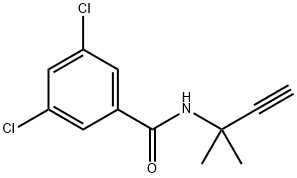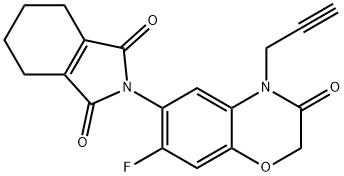Propyzamide
Synonym(s):Pronamide;Propyzamide
- CAS NO.:23950-58-5
- Empirical Formula: C12H11Cl2NO
- Molecular Weight: 256.13
- MDL number: MFCD00055346
- EINECS: 245-951-4
- SAFETY DATA SHEET (SDS)
- Update Date: 2024-12-18 14:15:30

What is Propyzamide?
Chemical properties
White Solid
Chemical properties
Pronamide is a colorless crystalline solid or powder.
The Uses of Propyzamide
Selective pre-emergence herbicide.
The Uses of Propyzamide
Herbicide.
The Uses of Propyzamide
Preemergence or postemergence herbicide used to control many perennial and annual grasses and broad-leaved weeds in ornamental trees and shrubs, forestry, fruits and vegetables
Definition
ChEBI: A member of the class of benzamides resulting from the formal condensation of the carboxy group of 3,5-dichlorobenzoic acid with the amino group of 2-methylbut-3-yn-2-amine. It is used as a systemic post-emergent herbicide for the control grass and broadle f weeds in a wide range of in a wide variety of fruit and root crops.
General Description
White solid. Used as a selective herbicide.
Reactivity Profile
3,5-DICHLORO-N-(1,1-DIMETHYL-2-PROPYNYL)BENZAMIDE is a chlorinated amide. Organic amides/imides react with azo and diazo compounds to generate toxic gases. Flammable gases are formed by the reaction of organic amides/imides with strong reducing agents. Amides are very weak bases (weaker than water). Imides are less basic yet and in fact react with strong bases to form salts. That is, they can react as acids. Mixing amides with dehydrating agents such as P2O5 or SOCl2 generates the corresponding nitrile. The combustion of these compounds generates mixed oxides of nitrogen (NOx).
Agricultural Uses
Herbicide: Pronamide is a selective herbicide used either before weeds emerge (pre-emergence), and/or after weeds come up (post-emergence). It controls a wide range of annual and perennial grasses, as well as certain annual broadleaf weeds. It is used primarily on lettuce and alfalfa crops, as well as on blueberries, ornamentals, fruit trees, forage legumes, and on pastures and rangelands. Pronamide is usually incorporated into the soil by cultivation, irrigation, or rain immediately following application. It is available in wettable powder and granular formulations. Registered for use in the U.S. and EU countries. A U.S. EPA restricted Use Pesticide (RUP).
Trade name
BENZAMIDE®; CAMPBELL'S RAPIER®; CLANEX®; KERB®; KERB 50 W®; KERB® PROPYZAMIDE 50; RH-315 RAPIER®; RONAMID®
Potential Exposure
A potential danger to those involved in the manufacture, formulation and application of this selective herbicide.
Environmental Fate
Biological. In the presence of suspended natural populations from unpolluted aquatic
systems, the second-order microbial transformation rate constant determined in the laboratory was reported to be 5 × 10–14 L/organisms-hour (Steen, 1991).
Soil. The major soil metabolite is 2-(3,5-dichlorophenyl)-4,4-dimethyl-5-methyleneoxazoline. The half-life in soil is approximately 30 days at 25°C (Hartley and Kidd, 1987).
Residual activity in soil is limited to approximately 2–6 months (Hartley and Kidd, 1987).
Chemical/Physical. Emits toxic fumes of nitrogen oxides and chlorine when heated
to decomposition (Sax and Lewis, 1987).
Propyzamide is hydrolyzed to 3,5-dichlorobenzoate by refluxing under strongly acidic
conditions (Humburg et al., 1989).
Shipping
UN3077 Environmentally hazardous substances, solid, n.o.s., Hazard class: 9; Labels: 9-Miscellaneous haz- ardous material, Technical Name Required.
Incompatibilities
Incompatible with oxidizers (chlorates, nitrates, peroxides, permanganates, perchlorates, chlorine, bromine, fluorine, etc.); contact may cause fires or explo- sions. Keep away from alkaline materials, strong bases, strong acids, oxoacids, epoxides. Compounds of the car- boxyl group react with all bases, both inorganic and organic (i.e., amines) releasing substantial heat, water and a salt that may be harmful. Incompatible with arsenic com- pounds (releases hydrogen cyanide gas), diazo compounds, dithiocarbamates, isocyanates, mercaptans, nitrides, and sulfides (releasing heat, toxic and possibly flammable gases), thiosulfates and dithionites (releasing hydrogen sulfate and oxides of sulfur).
Waste Disposal
Consult with environmental regulatory agencies for guidance on acceptable disposal practices. Generators of waste containing this contaminant (≥100 kg/mo) must conform with EPA regulations govern- ing storage, transportation, treatment, and waste disposal. In accordance with 40CFR165, follow recommendations for the disposal of pesticides and pesticide containers. Must be disposed properly by following package label directions or by contacting your local or federal environmental control agency, or by contacting your regional EPA office.
Properties of Propyzamide
| Melting point: | 153-155°C |
| Boiling point: | 340.9±42.0 °C(Predicted) |
| Density | 1.2742 (rough estimate) |
| refractive index | 1.5490 (estimate) |
| Flash point: | 2 °C |
| storage temp. | Keep in dark place,Sealed in dry,Room Temperature |
| solubility | Chloroform (Slightly), Methanol (Slightly) |
| form | Solid |
| pka | 12.30±0.46(Predicted) |
| color | White to Almost white |
| Water Solubility | 15mg/L(25 ºC) |
| λmax | 289nm(lit.) |
| Merck | 14,7872 |
| BRN | 882391 |
| CAS DataBase Reference | 23950-58-5(CAS DataBase Reference) |
| NIST Chemistry Reference | Propyzamide(23950-58-5) |
| EPA Substance Registry System | Pronamide (23950-58-5) |
Safety information for Propyzamide
| Signal word | Warning |
| Pictogram(s) |
 Health Hazard GHS08  Environment GHS09 |
| GHS Hazard Statements |
H351:Carcinogenicity H410:Hazardous to the aquatic environment, long-term hazard |
| Precautionary Statement Codes |
P201:Obtain special instructions before use. P273:Avoid release to the environment. P308+P313:IF exposed or concerned: Get medical advice/attention. |
Computed Descriptors for Propyzamide
New Products
4-Fluorophenylacetic acid 4-Methylphenylacetic acid N-Boc-D-alaninol N-BOC-D/L-ALANINOL Tert-butyl bis(2-chloroethyl)carbamate 3-Morpholino-1-(4-nitrophenyl)-5,6-dihydropyridin- 2(1H)-one Furan-2,5-Dicarboxylic Acid Tropic acid S-2-CHLORO PROPIONIC ACID ETHYL ISOCYANOACETATE 2-Bromo-1,3-Bis(Dimethylamino)Trimethinium Hexafluorophosphate (6-METHYL-[1,3]DITHIOLO[4,5-b]QUINOXALIN-2-ONE INDAZOLE-3-CARBOXYLIC ACID 4-IODO BENZOIC ACID (2-Hydroxyphenyl)acetonitrile 4-Bromopyrazole 5,6-Dimethoxyindanone 2-(Cyanocyclohexyl)acetic acid 4-methoxy-3,5-dinitropyridine 2-aminopropyl benzoate hydrochloride 1-(4-(aminomethyl)benzyl)urea hydrochloride diethyl 2-(2-((tertbutoxycarbonyl)amino) ethyl)malonate tert-butyl 4- (ureidomethyl)benzylcarbamate Ethyl-2-chloro((4-methoxyphenyl)hydrazono)acetateRelated products of tetrahydrofuran








You may like
-
 Propyzamide CAS 23950-58-5View Details
Propyzamide CAS 23950-58-5View Details
23950-58-5 -
 Propyzamide 99% (GC) CAS 23950-58-5View Details
Propyzamide 99% (GC) CAS 23950-58-5View Details
23950-58-5 -
 Propyzamide CAS 23950-58-5View Details
Propyzamide CAS 23950-58-5View Details
23950-58-5 -
 1975-50-4 98%View Details
1975-50-4 98%View Details
1975-50-4 -
 2-HYDROXY BENZYL ALCOHOL 98%View Details
2-HYDROXY BENZYL ALCOHOL 98%View Details
90-01-7 -
 2-Chloro-1,3-Bis(Dimethylamino)Trimethinium Hexafluorophosphate 221615-75-4 98%View Details
2-Chloro-1,3-Bis(Dimethylamino)Trimethinium Hexafluorophosphate 221615-75-4 98%View Details
221615-75-4 -
 14714-50-2 (2-Hydroxyphenyl)acetonitrile 98+View Details
14714-50-2 (2-Hydroxyphenyl)acetonitrile 98+View Details
14714-50-2 -
 118753-70-1 98+View Details
118753-70-1 98+View Details
118753-70-1